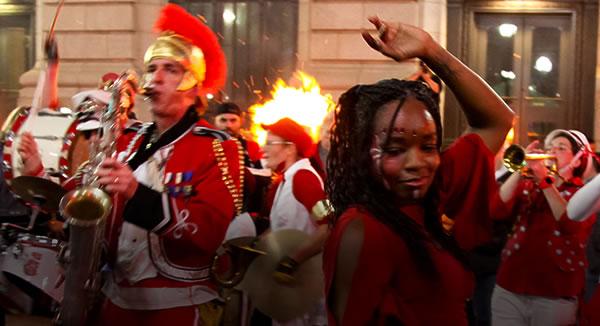Beyond the Building: Performing Arts & Transforming Place

Convening Archive
Performances have multifaceted ways that they transform places, people's relationships with their communities, and community development processes. On November 3, 2014, the Arts Endowment hosted the "Beyond the Building: Performing Arts and Transforming Place" convening to develop a better understanding of how performance-based organizations, and the artists they engage, transform places through their artistic practices.
The convening brought together representatives of performing arts organizations from across the country and NEA staff for a day-long investigation of this topic. Barbara Schaffer Bacon, co-director of Animating Democracy, served as facilitator. Support for the convening was also provided by ArtPlace America.
The convening included public presentations and large group discussions as well as small group breakout sessions. The public presentations were broadcast live; the video archives of the four public sessions are available below.
Beyond the Building: Performing Arts & Transforming Place white paper was published after the convening.
Morning Session 1:
Video
Introductions
Designated participants presented a summary of the pre-survey question responses.
- When is performance "Placemaking"?
- Discuss the range of activity, from community engagement and development to placemaking strategies that performing arts organizations employ.
- Address whether performing arts groups feel excluded from the conversations surrounding creative placemaking, and if so, why.
Morning Session 2:
Video
Presentations from Morning Small Group Discussions on the following topics/questions:
- Language & Framing: What does "creative placemaking" mean to your organization? Has your organization framed "creative placemaking" in other terms, or in other language?
- Place & Mission: How does the work of your organization relate to the place and community within which it is situated? In what ways have you engaged in creative placemaking strategies? How might you see creative placemaking as part of your organization's operational or artistic missions or philosophy?
- Events & Effects: How can temporary performance events transform and imbue lasting meaning and change within particular spaces and communities? How are they tied to broader social and environmental strategies?
Snapshot presentation: Center for Performance and Civic Practice. Presentation by Michael Rohd and his work at the Center for Performance and Civic Practice.
Snapshot presentation: Ballet Austin. Presentation by Cookie Ruiz on Ballet Austin's Light / The Holocaust & Humanity Project.
Afternoon Session 1
Video
Snapshot presentation: Alternate Roots. Presentation by Carlton Turner on the work of Alternate Roots and their membership network.
Continuation of Morning Discussion
Snapshot presentation: On the Boards. Presentation by Sarah Wilke on the work of On the Boards.
Survey Findings: Part II: Designated participants presented a summary of the pre-survey question responses:
- What are the opportunities and challenges to performing arts organizations engaging in placemaking strategies?
- Discuss the challenges, both internally and externally, for performing artists or organizations seeking to engage in placemaking.
Afternoon Session 2
Video
Presentations from Afternoon Small Group Discussions. Participants regroup in a larger forum to share summaries from small group discussions on the following topics/questions:
- Issues & Impact: What are the types of community issues or needs best addressed by placemaking activities? What is the intent of the activity, and the impact?
- Relationships & Resources: What are the relationships and resources necessary for the performing arts to be effectively engaged in placemaking activities? What are the goals and desires of each stakeholder in this work? How and when are stakeholders engaged?
- Addressing Equity: How can performing arts organizations address issues of social and cultural inequalities and equitable access within their communities using placemaking strategies?
Group Conclusions
Wrap up

